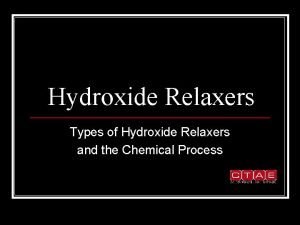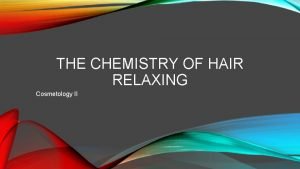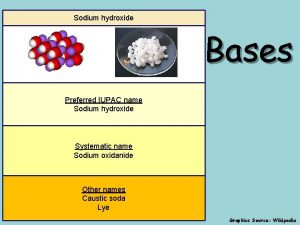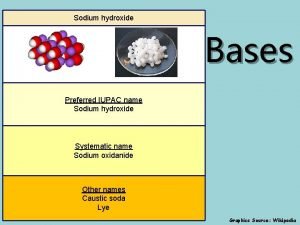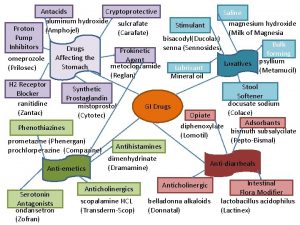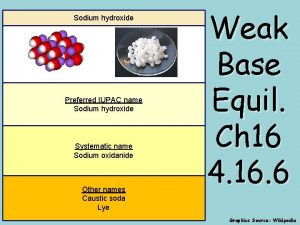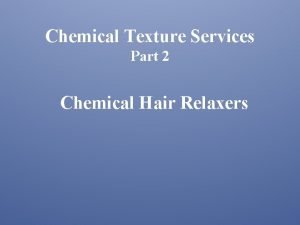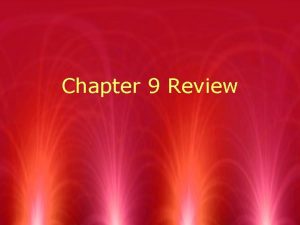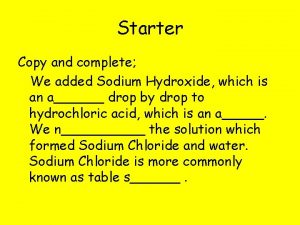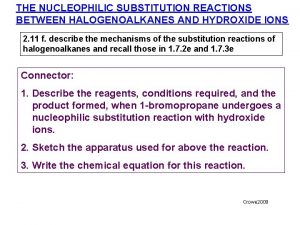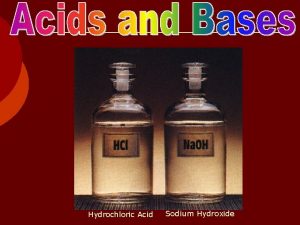Hydroxide Relaxers Types of Hydroxide Relaxers and the
















- Slides: 16

Hydroxide Relaxers Types of Hydroxide Relaxers and the Chemical Process

Hydroxide Relaxers n n Hair Relaxer is a product used to permanently straighten naturally curly hair. Active ingredient in all hydroxide relaxers is hydroxide ions. Hydroxide Relaxers are highly alkaline, ranging from 12 -14 on the Ph scale. Hydroxide Relaxers are most commonly used in the salon.

Types of Hydroxide Relaxers Active Ph Sodium 12. 5 Hydroxide 13. 5 Market No-Mix Lye Lithium & Potassium Hydroxide Guanidine Hydroxide 12. 5 – 13. 5 No-Mix Lye 13 13. 5 No Lye Positive Effective for curly hair Negative Scalp irritations Hair damage Effective Scalp for curly irritations hair Hair damage Less Could dry irritation hair

Phases in Hair Relaxing Chemical Change- Begins as soon as relaxer is applied to hair. A complete change occurs in the composition of the hair. Physical Change- Is smoothing the hair, and rinsing the hair. It is a change in the state of matter.

Chemical Hair Straightening Process Overview n n 1. Apply Relaxer: Both H and S bonds hold polypeptide chains in curly position. 2. Process: All H bonds are broken, most S bonds are broken. Hair begins to relax. 3. Neutralize: Polypeptide chains are in straight position. New hair structure is harden. 4. Rinse and Condition: New cross links form, resulting in straight hair.

Chemical Changes in Relaxers n n n In the relaxer process, chemical changes occur, breaking and reforming the structure of hair bonds. Hydroxide ions breaks disulfide bonds by acidic hydrogen atoms next to the sulfur atoms. Once hydrogen bonds have been broken, it can never be reform. Instead lanthionine bonds are formed.

Lanthionization Process n n During the chemical process, (chemical change) Hydroxide Relaxers breaks the disulfide bonds differently than Thio Relaxers. Hydroxide Relaxers removes one atom of sulfur, making it a lanthionine bond in a process call lanthionization.

Hydroxide Neutralizers n n Neutralizers reforms the bonds into a straight pattern. The hydroxide relaxers deactivates and neutralizes the alkaline left in the hair. A neutralizing shampoo must be used following the rinse to normalize the Ph of the hair. Some neutralizer have built-in color indicators that signals when the hair has returned to a normal Ph.

Sodium Hydroxide Relaxers- (Na. OH) n n Sodium Hydroxide is the most commonly used relaxer on the market. Also called Lye Relaxer. Hair can swell more than twice its size. Use as packaged, no mixing required.

Lithium and Potassium Hydroxide Relaxers n n Sometimes advertised as “nolye” relaxers, which can be very misleading. Products are also highly corrosive and extreme damage can still occur. The chemistry and performance of the relaxer is very similar to sodium hydroxide relaxers. Hydroxide ion is active ingredient, making it also incompatible with thio permanents and relaxers.

Guanidine Hydroxide Relaxers n n n Also advertised as “no-lye” relaxer. Contents of product must be mixed, (cream and liquid). Cream contains calcium hydroxide. Liquid contains guanidine carbonate. Will not straighten effectively unless mixed correctly and equal porportions. Recommended for sensitive scalps and usually sold for home use.

Two Types of Relaxer Formulas n n Base Formula- Requires the application of petroleum cream to scalp for protection against skin irritations. Applied before relaxer product. No-Base Formula- Base cream is already in relaxer, which melts at body temperature. Provides thin oily protective coating for scalp.

Hair Relaxer Strengthens n n Relaxers are marketed and categorized by the strength of the product. Chemically, the strength depends on the amount hydroxide ions are present in the product.

Relaxer Strengths n n n Mild- Formulated for fine, color-treated, or slightly damaged hair. Regular. Recommended for normal hair with medium curl. Super- Intended for coarse hair that is extremely curly.

Conclusion n Hydroxide Relaxer are highly caustic and can cause extreme damage to hair. Professionalism and safety must be used. Relaxers come in different types, strengths, bases, and ingredients. Selection of which relaxer to use must be analyzed with care. Hydroxide Relaxers are NOT COMPATIABLE with Thio Relaxers. Extreme damage could occur.

Works Cited n n n www. wikipedia. com Milady’s Standard Textbook, copyright 2004 Hair Structure and Chemistry Simplified, John Halal, copyright 2009
 Guanidine hydroxide relaxer
Guanidine hydroxide relaxer Chapter 20 chemical texture services vocabulary
Chapter 20 chemical texture services vocabulary Sodium hydroxide relaxers are commonly called
Sodium hydroxide relaxers are commonly called Hát kết hợp bộ gõ cơ thể
Hát kết hợp bộ gõ cơ thể Frameset trong html5
Frameset trong html5 Bổ thể
Bổ thể Tỉ lệ cơ thể trẻ em
Tỉ lệ cơ thể trẻ em Chó sói
Chó sói Thang điểm glasgow
Thang điểm glasgow Chúa sống lại
Chúa sống lại Các môn thể thao bắt đầu bằng tiếng bóng
Các môn thể thao bắt đầu bằng tiếng bóng Thế nào là hệ số cao nhất
Thế nào là hệ số cao nhất Các châu lục và đại dương trên thế giới
Các châu lục và đại dương trên thế giới Công thức tính thế năng
Công thức tính thế năng Trời xanh đây là của chúng ta thể thơ
Trời xanh đây là của chúng ta thể thơ Mật thư anh em như thể tay chân
Mật thư anh em như thể tay chân Phép trừ bù
Phép trừ bù
